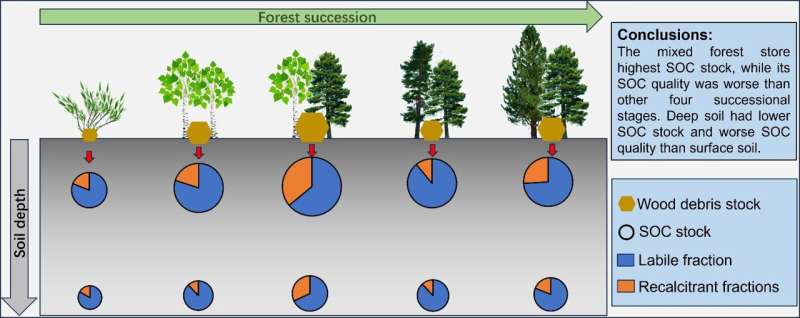This article has been reviewed according to Science X's editorial process and policies. Editors have highlighted the following attributes while ensuring the content's credibility:
fact-checked
proofread
Mixed forests store more soil organic carbon than pure forests, researchers find

Soil stores large amounts of organic carbon, whose dynamic changes can cause a huge impact on the global climate system. Forest succession is a long-term ecological process that can exert powerful effects on soil organic carbon (SOC) due to variations in plant community composition, microenvironment, plant debris stock, soil nutrient availability and microbial community composition among different successional stages.
Clarifying the dynamic changes of SOC across the forest successional series will provide insights into the global soil carbon cycle and improve the accuracy of terrestrial carbon cycle models. However, existing literature mostly focuses on the changes in SOC in the surface soil across forest succession, while SOC buried in deep soil is often neglected. Moreover, how SOC quality changes across the forest successional series remains unclear. Despite these limitations, there is a lack of comprehensive investigation of the changes in SOC stock and quality across the forest succession.
In a study published in the journal Forest Ecosystems, a team of researchers has investigated the stock and quality of SOC at 1-m soil profile across a subalpine forest series located southeast of the Tibetan Plateau. The series includes shrubs, deciduous broad-leaved forest, broadleaf-conifer mixed forest, middle-aged coniferous forest and mature coniferous forest.
The researchers found that the SOC stock exhibited a hump-shaped response pattern from the initial to the terminal forest successional stage, and the mixed forest stored the highest amount of SOC compared with other forest types. This is attributed to higher wood debris storage in mixed forest.
Meanwhile, the SOC quality in mixed forest was poorer than that of the other forest types. In addition, deep soil was found to contain, on average, 66% of the topmost meter's SOC stocks. Notably, SOC quality in deep soil was better than that of surface soil. These findings highlight the importance of mixed forest and plant debris in maintaining forest carbon sequestration. The high proportion of SOC stock and better SOC quality indicate that deep soil has tremendous potential to release plentiful carbon dioxide under global change.
According to Fei Li, first author of this study, the findings have the following implications: (1) more mixed forest should be constructed for further forest management and cultivation to promote terrestrial carbon sequestration; (2) preserving plant debris is a critical strategy for sustainable forest management; and (3) surface and deep soil should be separated when models simulate the dynamic changes of SOC under global change.
More information: Fei Li et al, The changes in soil organic carbon stock and quality across a subalpine forest successional series, Forest Ecosystems (2024). DOI: 10.1016/j.fecs.2024.100203
Provided by KeAi Communications Co.



















